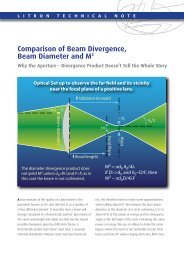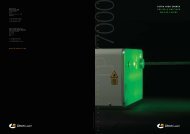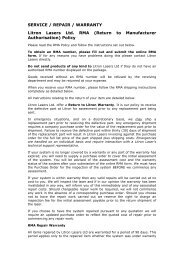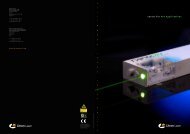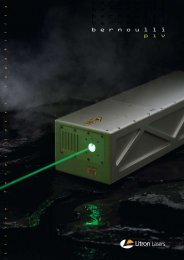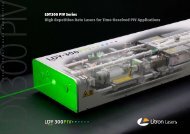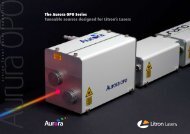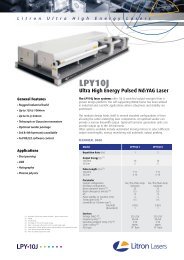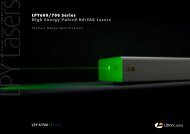LPM 230 Series Photodiode Laser Energy Monitors ... - Litron Lasers
LPM 230 Series Photodiode Laser Energy Monitors ... - Litron Lasers
LPM 230 Series Photodiode Laser Energy Monitors ... - Litron Lasers
You also want an ePaper? Increase the reach of your titles
YUMPU automatically turns print PDFs into web optimized ePapers that Google loves.
<strong>LPM</strong> <strong>230</strong><br />
L i t r o n T o t a l L a s e r C a p a b i l i t y<br />
<strong>LPM</strong> <strong>230</strong> <strong>Series</strong><br />
<strong>Photodiode</strong> <strong>Laser</strong> <strong>Energy</strong> <strong>Monitors</strong> from <strong>Litron</strong>
<strong>LPM</strong> <strong>230</strong><br />
State of the Art <strong>Energy</strong> Monitoring Devices for <strong>Laser</strong> Users.<br />
FEATURES<br />
• Pulse energies from 10μJ to 30J<br />
• Very compact size<br />
• 400nm- 650nm (typically depending on<br />
the choice of the detection photodiode)<br />
• Accurately temperature stabilised<br />
photodiode<br />
• Pulse repetition rates of up to 1000Hz<br />
• Exceptional linearity<br />
• Repeatability errors of less than 0.2%<br />
• High damage threshold -<br />
greater than 3J/cm2 Q-switched<br />
• Rugged design with integrated 4 digit<br />
energy display<br />
• Traceable calibrations available at<br />
1535nm, 1064nm, 694nm and 532nm<br />
• Comprehensive software suite with<br />
datalogging capability for use with<br />
Microsoft® Windows®<br />
• RS232 interface<br />
The <strong>Litron</strong><br />
LTM 530 In-line <strong>Energy</strong><br />
Monitor <strong>Series</strong><br />
The <strong>LPM</strong><strong>230</strong> series of energy<br />
monitors are extremely<br />
compact, portable, photodiode<br />
based instruments. They have<br />
been designed to facilitate the<br />
easy, accurate measurement of<br />
pulsed laser output energy, and to<br />
allow detailed performance monitoring<br />
of laser systems. Their small<br />
size makes them ideal for laser<br />
test and service engineers.<br />
The detection electronics gives<br />
exceptional linearity over the<br />
entire dynamic range of the device,<br />
and gives rise to<br />
repeatability<br />
errors of less than 0.2%.<br />
The type of detection diode that is<br />
chosen allows for different<br />
spectral ranges to be<br />
covered accurately. The<br />
maximum measurable<br />
pulse length is user selectable up<br />
to 50ms via theincluded software<br />
suite. The optional oscilloscope<br />
output allowsthe temporal profile<br />
of the laser pulse to be observed.<br />
It can beconfigured either as a 50Ω<br />
output or as an integrated output<br />
with a time constant of 500μs.<br />
The head contains a 4 digit LED<br />
display, allowing the unit to be<br />
used as a ‘stand-alone’ device. The<br />
inclusion of a serial interface<br />
is standard on all models and allows<br />
full data logging and<br />
statistical analysis of the laser<br />
output with the software<br />
package included. Fully<br />
automatic re-calibration<br />
can be performed in<br />
conjunction with our<br />
in-line transfer standard meter.<br />
Our proprietary, patent pending,<br />
optical configuration gives a high<br />
uniformity in the reading over<br />
the whole of the<br />
30mm input<br />
aperture, as well<br />
as giving the<br />
device a low<br />
angular sensitivity,<br />
minimising the<br />
effects of small<br />
misalignments.<br />
We are happy to<br />
discuss your custom requirements<br />
should one of our standard range<br />
detailed overleaf not be suitable<br />
for your application.
<strong>LPM</strong> <strong>230</strong><br />
Our policy is to improve the<br />
design and specification of our<br />
products. The details given in<br />
this document are not to be<br />
regarded as binding.<br />
<strong>LPM</strong> <strong>230</strong> <strong>Series</strong> <strong>Photodiode</strong> <strong>Laser</strong> <strong>Energy</strong> <strong>Monitors</strong><br />
SPECIFICATIONS<br />
Model <strong>Photodiode</strong> Wavelength <strong>Energy</strong> Range 1,7 Oscilloscope Maximum Pulse Maximum Input Calibration<br />
Type Range (nm) Output Input Frequency Pulse Length Available at (nm)<br />
<strong>LPM</strong><strong>230</strong>-1 Silicon 400-1100 0.01-60 mJ See Note 2 See Note 3 See Note 3 1064, 532, 694<br />
<strong>LPM</strong><strong>230</strong>-2 0.1-600 mJ<br />
<strong>LPM</strong><strong>230</strong>-3 1-3000 mJ<br />
<strong>LPM</strong><strong>230</strong>-4 10 mJ - 30 J<br />
<strong>LPM</strong>231-1 InGaAs 900-1650 0.01-60 mJ See Note 2 See Note 3 See Note 3 1535, 1064<br />
<strong>LPM</strong>231-2 0.1-600 mJ<br />
<strong>LPM</strong>231-3 1-3000 mJ<br />
<strong>LPM</strong>231-4 10 mJ - 30 J<br />
ALL MODELS<br />
Input Aperture Diameter 30mm<br />
Damage Threshold >50J/cm 2 (normal mode pulses) 3J/cm 2 (Q-switched pulses)<br />
Absolute accuracy at ±3% or 1 digit whichever is greater<br />
calibrated wavelength 4<br />
Error in repeatability 6 Better than ±0.2%<br />
Positional accuracy ±5% from centre to edge<br />
across input aperture 5<br />
Display type 4 digit green LED<br />
Dimensions (mm) 125 L x 76 W x 65 H<br />
Weight (g) 880<br />
Outputs RS232, optional 50Ω or integrated oscilloscope output<br />
Power requirements 6V DC, 1A (Adaptor supplied)<br />
HEAD OFFICE<br />
<strong>Litron</strong> <strong>Laser</strong>s Ltd<br />
8 Consul Road<br />
Rugby<br />
Warwickshire CV21 1PB<br />
England<br />
T +44 (0)1788 574444<br />
F +44 (0)1788 574888<br />
E sales@litron.co.uk<br />
NORTH AMERICAN OFFICE<br />
<strong>Litron</strong> <strong>Laser</strong>s North America<br />
2449 Arnica Drive<br />
Bozeman<br />
MT 59715<br />
USA<br />
NOTES<br />
1. The maximum average power loading in free air is 10W. Custom energy ranges<br />
are available.<br />
2. An oscilloscope output is available on all models. For an output that is integrated<br />
with a time constant of about 500μs append -A to the model number and for a 50Ω<br />
output capable of resolving 500ps pulses append -B to the model code.<br />
3. The maximum pulse width is user settable up to 50ms. The device works by<br />
integrating the incident energy over the set period. The maximum input frequency<br />
is therefore a function of the maximum pulse width.<br />
For a 50ms maximum pulse width, the maximum repetition rate is 18Hz and for a<br />
500μs pulse width the maximum<br />
repetition rate is 1kHz.<br />
4. Input beam incident upon centre of aperture and normal to surface. <strong>Energy</strong><br />
>10% of full scale reading.<br />
5. 4mm diameter input beam across the central 28mm of the input aperture. Larger<br />
input beams may give rise to a less uniform response.<br />
6. For integration time 10% of full scale reading.<br />
7. Full scale energy may vary for different wavelengths with a given device due<br />
to the spectral response of the detector and optics.<br />
T +1 (406) 522 7566<br />
F +1 (406) 522 7567<br />
0111:8<br />
E sales@litronlasers.com www.litronlasers.com PB




